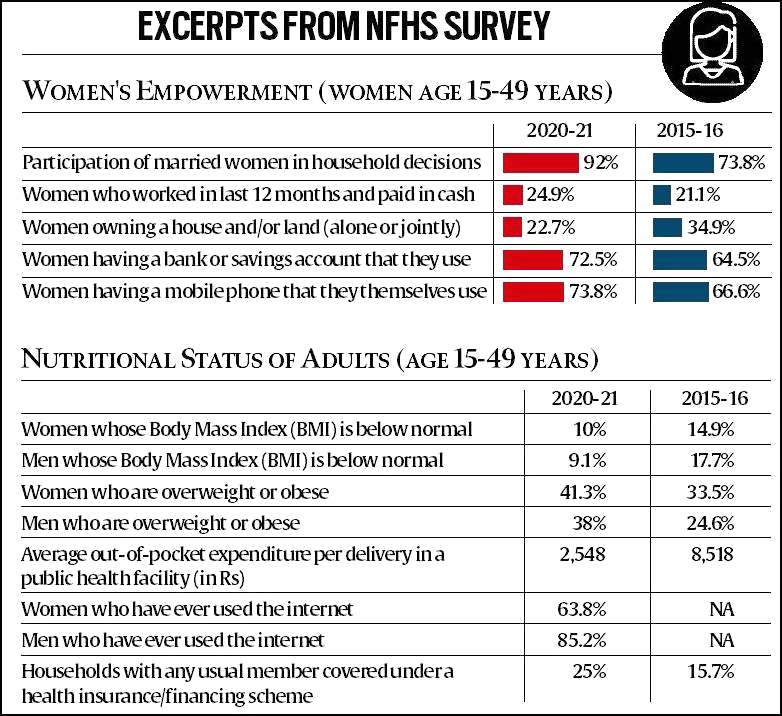Women Related Data: NFHS 5 | 27 Nov 2021
Why in News
Recently, the latest data from the National Family Health Survey (NFHS 2019-21) has been released.
- Earlier in 2020, the first-phase data of the NFHS-5 2019-20 was released by the Ministry of Health and Family Welfare, which provided data on various issues related to women in india.
Key Points
- Prevalence of Child Marriage:
- The share of women aged 20-24 who married before turning 18 has declined from 27% to 23% in the last five years.
- Child marriage is a key determinant of high fertility, poor maternal and child health, and lower social status of women.
- West Bengal and Bihar, with around 41% such women each, had the highest prevalence of girl child marriage.
- The maximum reduction in the proportion of underage marriages was observed in Rajasthan, Madhya Pradesh, and Haryana.
- The share of women aged 20-24 who married before turning 18 has declined from 27% to 23% in the last five years.
- Rampant Anaemia:
- As many as 57% women aged 15-49 were anaemic in 2019-21, compared to 53% in 2015-16, while the same for men rose from 22.7% to 25%.
- The most formidable increase—8.5% was observed for children aged 6-59 months (67.1%).
- Among larger states, West Bengal and Kerala reported the highest and lowest prevalence, respectively, of anaemic women.
- Child anaemia rates worsened the most in Assam, Mizoram, Chhattisgarh, and Odisha.
- Improving Amenities:
- All states, except Manipur, Meghalaya, Assam and Jharkhand, had over 90% population with access to improved drinking water sources.
- Bihar, Jharkhand etc states had almost doubled the access since 2015-16, but most fell below the 75% mark.
- Women who own House:
- The number of women who own a house or land in Delhi, either alone or jointly, has significantly dipped over the past five years.
- While the percentage of women who had a house or land registered in their name in 2015-16 was around 35%, it dipped to 22.7% in 2020-21.
- Women who have a Bank Account:
- It has gone up 8% and women who have a mobile phone that they use is up by 7%.
- Access to Internet:
- The percentage of women who have ever used the internet was around 64% as compared to 85% men. This data was not available in the previous survey.
- Participation in the Household Participation:
- It has gone up from around 74% in 2015-16 to 92% now. The participation of married women in household decisions includes health care for self, making major household purchases, and visits to her family or relatives, etc.
- Out-of-Pocket Expenditure:
- It went from Rs 8,518 to Rs 2,548 in five years. Average out-of-pocket expenditure has seen a significant improvement in the per delivery in a public health facility.
- Rise in Obesity:
- Obesity among both men and women has risen. While 41.3% of women are now overweight or obese, this figure is 38% for men.
- The rise in the percentage of men who are overweight or obese, however, has been faster in men than in women.
- High Malnutrition:
- The share of under-five children who were stunted (too short for age), wasted (low weight for height), or underweight has declined.
- However, every third child still suffers from chronic undernourishment, and every fifth child is acutely malnourished.
- Stunting: Meghalaya had the prevalence, followed by Bihar while Rajasthan, Madhya Pradesh, Jharkhand recorded declines of 5-7% since 2015-16.
- Wasting: Bihar had the highest prevalence of underweight children, followed closely by Gujarat.
National Family Health Survey (NFHS)
- The National Family Health Survey (NFHS) is a large-scale, multi-round survey conducted in a representative sample of households throughout India.
- The Ministry of Health and Family Welfare (MoHFW), Government of India has designated the International Institute for Population Sciences (IIPS) Mumbai, as the nodal agency for providing coordination and technical guidance for the survey.
- IIPS collaborates with a number of Field Organizations (FO) for survey implementation.
- The survey provides state and national information for India on:
- Fertility, Infant and child mortality, the practice of family planning, Maternal and child health, Reproductive health, Nutrition, Anaemia, Utilization and quality of health and family planning services
- Each successive round of the NFHS has had two specific goals:
- To provide essential data on health and family welfare needed by the Ministry of Health and Family Welfare and other agencies for policy and programme purposes.
- To provide information on important emerging health and family welfare issues.
- The funding for different rounds of NFHS has been provided by USAID, the Bill and Melinda Gates Foundation, UNICEF, UNFPA, and MoHFW (Government of India).
Way Forward
- The NFHS findings are a reminder of the urgent need to close gaps in girls’ education and address the pathetic nutritional status of women and children.
- Current times require integrated and coordinated efforts from all health institutions, academia and other partners directly or indirectly associated with the health care services to make these services accessible, affordable and acceptable to all.

